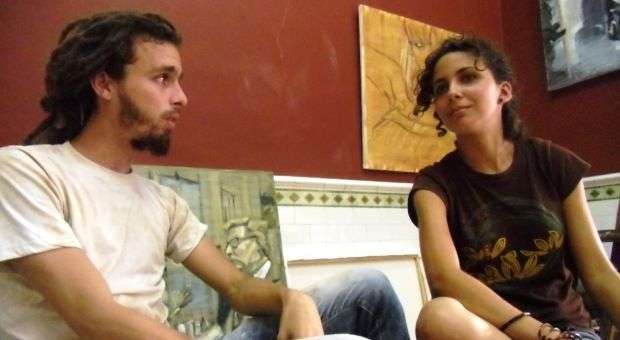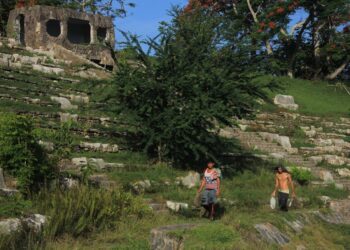Economic liberalization in Cuba has made attractive for some artists the ability to set up a space where they can work and sell their work at the same time.
It is the combination of a duet usually separated (creator / seller) but in the daily national, charged with onerous intermediaries, it is a source of income and motivation to exponents of various manifestations.
Here are some stories.
Vladimir
Regular participant in events and competitions, Vladimir Rodriguez has managed to legitimize his visual discourse as one of the leading exponents of the “province” art (that at times ignored by their outside Havana quality).
“Years ago to sell your work yourself amounted to almost consider yourself an outcast,” he says now he decided to set up a studio-workshop and begin to appreciate the result of bypassing intermediaries.
“Here I establish a more direct link that what I can achieve through an institution that represents 500 people. I talked with people from Australia to Europe, America and Africa and the exchange with them is already in itself an important step in the promotion of my career, “he says.
“Good morning,” interrupted a young woman who holds the hand of a small child, already skilled with the use of mobile phone as a camera, “Can we go to see the exhibition,” asks and gets a lackadaisical smile for response from the artist, in nod. “See?,” Vladimir akss, “even if she doesn’t buy anything, this visit is a pleasure” …
José Carlos and Yahily
Before other established artists dare to try, two youngsters jumped prejudices and stereotypes to try to get a way of life. José Carlos Beltran, 23, and Yahily Martínez Molina, 22, exhibited and sold in “LAND”, their own promised land.
José Carlos y Yahily
“We started in Trinidad at 18, attached to most commercial creation for tourism, the” candonga “. There, despite being widespread stereotype sale (black ladies, “almendrones” …), there were also some spaces for the defense of the proposed higher level, and with them we learned “they told us.
“We had to finish our experience in Trinidad because it was not easy to keep a rental to live and one to sell, so after returning to Cienfuegos we noticed that here there was no gallery and decided to set it up.”
Lourdes
Even before that Jose Carlos, Yahily and Vladimir, another artist had a personal space to create and sell, although promoted as cultural initiative of the government in the province.
Lourdes Trigo, fashion designer and UNESCO Award in 2006 for the rescue of weaving and embroidery, received two years ago a central space in the city known as the Pearl of the South, used previously as a playroom for children.
She tried first to market with the state retail chain Caracol, but failed. “I worked on consignment. I put the piece at a price; they incorporated the 10% tax, on behalf of the Cuban Cultural Fund (FCBC) and a profit margin of more than 200% for the company “.
“A dress that I tagged at 20 CUC, was exposed to the public in fifty-odd, and it took too long to sell, although it was sold faster than similar imported ones,” the designer explains.
Ready to find her niche, Lourdes has developed a line of up-to-date couture. “In Trinidad there are artisans and craftsmen who work wonders with their hands, but are unrelated to fashion. This limits the value of their work, despite the rarity of its exercise in industrial modernity “.
No matter how sui generis your proposal is, Lourdes has found that, in fact, designing is not the same than selling.
Come in and buy…
“Here I offer my work without formal concessions”, Vladimir says: “I’m living out of selling the same work I use to express myself.”
On the other hand, José Carlos defends the art they do in LAND, but he doesn’t refuse certain types of business demands. “From time to time come and ask me 10 or 20 Chevrolet and I make them because at the end it means money and I need it”.
Yahily objects to reaffirm the status of conceptual art they sell in their study. “There is a foreign market that has refined taste, and many if they come and buy a set of black ladies or Chevrolet do it to acquire a souvenir, because when they go to buy a work of another level they know what they are buying.”
Before opening their studios / galleries / workshops, these artists should sell their works through the intermediate state: the FCBC, or as they simply call it “the Fund”.
“The difference in sales is substantial,” Vladimir says, “by the management we can do and it is always very interesting for the buyer to know the artist, complemented by the creator’s own argument the meaning of a work.”
In addition, when dealing directly with customers they can offer cheaper prices, whenever they want.
“Generally we work with the same price than the Fund,” Rodriguez says, “but here pay 10 percent of income to the representative, over seven percent to Onat (the Treasury). If the box is sold in a gallery institution, the Fund reserves 30 percent of income, plus seven percent to Onat. That margin of 20 percent difference between selling there and do it there gives me more opportunities here. “
Lourdes and LAND youth experience a similar situation.
“From my sales 20 percent is for the Fund and 5 percent for Onat, but I have to deposit with the representative all daily income. We are demanding that this situation will change because it is a problem. When I want to reinvest I have troubles, because sometimes I see the opportunity to buy raw materials and I have no money until the monthly bill arrives, “the designer says.
Despite this drawback, the four interviewees claim they are profiting with this method of sale. “And that is even when we’re not in high tourist season,” Vladimir insists, who hopes the soon arrival of groups of Americans regulars to the city in recent years.
Many of the costs in the galleries-workshop is spent in rehabbing of the facilities, old private houses that need rehabilitation. “There are still many things missing like carpet on the floor, led lights and glass in the windows,” Jose Carlos said while watching the red and white walls of his space.
“They were places that were not designed to display art. Now I’m trying to convert what is my idea of what may be a cultural center, in the place where people also come to enjoy the works and not just buy “Vladimir says.
Openness also means relying on existing state representation, which forces them to sell paintings and sculptures in the presence of an officer of the Fund, although they are not specially protected creations by national legislation (such as engravings). For others, being close to the headquarters of FCBC is no guarantee of promptness in the presence of the representative.
“A person can come at eight in the evening when no one is working at the Fund and I cannot sell the work until the next morning,” Rodriguez reveals. “If I sell it and this person has a problem at customs for not having the documents required, the Fund is not responsible for interceding in that circumstance.”
“The country has to reach the point where artists in these spaces have the means in our power to provide the buyer with all the guarantees that the product we sell can leave the country without setbacks”, Vladimir says.
The promotion of the cultural is another common issue for these four exponents of the opening. “We have to rely only on chance that the client passes by the front door,” Yahily explains, who longs for a website and other media that allow them to reach beyond their walls.
For these creators authorized advertising platforms are still not enough, like the yellow pages of the phone book or the internet connection through the expensive and limited navigation facilities.
Competition also takes on dividends. Lourdes felt strongly the impact of house selling clothes imported from Ecuador or any other country, which proliferated under the license of “dressmaker or tailor” in the opening to self-employment since 2011.
“This year marketing has been very difficult for that unfair competition we face. I say unfair because those people do not pay the taxes I pay and do not produce the parts, but they resell “Trigo says.
Despite the ups and downs of the market and others, the artistic proposals survive and expand. Living to sell art long ago ceased to be cause for banning to become a new and legitimate opportunity to reach prosperity.










